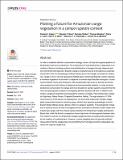Files in this item
Plotting a future for Amazonian canga vegetation in a campo rupestre context
Item metadata
| dc.contributor.author | Zappi, Daniela C | |
| dc.contributor.author | Moro, Marcelo F | |
| dc.contributor.author | Walker, Barnaby | |
| dc.contributor.author | Meagher, Thomas | |
| dc.contributor.author | Viana, Pedro L | |
| dc.contributor.author | Mota, Nara F O | |
| dc.contributor.author | Watanabe, Mauricio T C | |
| dc.contributor.author | Nic Lughadha, Eimear | |
| dc.date.accessioned | 2019-08-06T13:30:01Z | |
| dc.date.available | 2019-08-06T13:30:01Z | |
| dc.date.issued | 2019-08-05 | |
| dc.identifier | 260422338 | |
| dc.identifier | 45ee8e22-d8ec-4043-8d31-66da3454b7d5 | |
| dc.identifier | 31381566 | |
| dc.identifier | 85070290030 | |
| dc.identifier | 000484993600006 | |
| dc.identifier.citation | Zappi , D C , Moro , M F , Walker , B , Meagher , T , Viana , P L , Mota , N F O , Watanabe , M T C & Nic Lughadha , E 2019 , ' Plotting a future for Amazonian canga vegetation in a campo rupestre context ' , PLoS ONE , vol. 14 , no. 8 , e0219753 . https://doi.org/10.1371/journal.pone.0219753 | en |
| dc.identifier.issn | 1932-6203 | |
| dc.identifier.uri | https://hdl.handle.net/10023/18257 | |
| dc.description | This work was supported by CNPq project (455505/2014-4) to all authors; The MPEG/ITVDS/FADESP Term of Agreement (01205.000250/2014-10); DCZ – CNPq productivity grant; NFOM - Coordenação de Aperfeiçoamento de Pessoal de Nível Superior (BR- 88887/130640/2016-00). | en |
| dc.description.abstract | In order to establish effective conservation strategy, drivers of local and regional patterns of biodiversity need to be understood. The composition of local biodiversity is dependent on a number of factors including evolution and redistribution of lineages through dispersal and environmental heterogeneity. Brazilian canga is characterised by a ferrugineous substrate, found both in the Iron Quadrangle of Minas Gerais and in the Carajás mountains in Amazonia. Canga is one of several specialised habitat types comprising Brazilian campo rupestre, a montane vegetation found within or adjacent to several major Brazilian bioregions, including the Atlantic Forest and Amazonia, with exceptionally high levels of diversity and endemism arising from both history of dispersal and environmental variation. In order to inform biodiversity conservation for canga, and more broadly for campo rupestre, we performed floristic and phylogenetic analyses investigating affinities between 28 sites on different substrates (canga and quartzite) and geographic locations (Carajás, Pará [Amazonia]; Cadeia do Espinhaço, Minas Gerais; Chapada Diamantina, Bahia). Through analysis of 11204 occurrences of 4705 species of angiosperms, we found that Amazonian Carajás canga plant communities formed a cohesive group, distinct from species assemblages found in Eastern Brazil (Minas Gerais, Bahia), either on canga or quartzite. The phylogenetic megatree of species across all sites investigated shows associations between certain clades and Amazonian canga, with few shared species between the Amazonian Carajás and Eastern Brazil sites, while the floristic comparison shows high levels of heterogeneity between sites. The need for reserves for Amazonian Carajás canga has been recognized and addressed by the creation of a national park. However, current sampling does not provide sufficient reassurance that the canga areas now benefitting from full legal protection adequately represent the regional canga flora. | |
| dc.format.extent | 19 | |
| dc.format.extent | 5411874 | |
| dc.language.iso | eng | |
| dc.relation.ispartof | PLoS ONE | en |
| dc.subject | QH301 Biology | en |
| dc.subject | DAS | en |
| dc.subject.lcc | QH301 | en |
| dc.title | Plotting a future for Amazonian canga vegetation in a campo rupestre context | en |
| dc.type | Journal article | en |
| dc.contributor.institution | University of St Andrews. Centre for Biological Diversity | en |
| dc.contributor.institution | University of St Andrews. Scottish Oceans Institute | en |
| dc.contributor.institution | University of St Andrews. St Andrews Sustainability Institute | en |
| dc.contributor.institution | University of St Andrews. Centre for Research into Ecological & Environmental Modelling | en |
| dc.contributor.institution | University of St Andrews. School of Biology | en |
| dc.identifier.doi | 10.1371/journal.pone.0219753 | |
| dc.description.status | Peer reviewed | en |
This item appears in the following Collection(s)
Items in the St Andrews Research Repository are protected by copyright, with all rights reserved, unless otherwise indicated.

